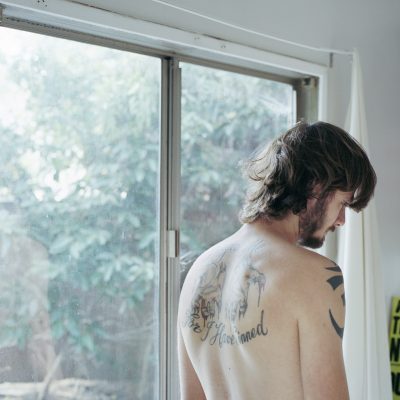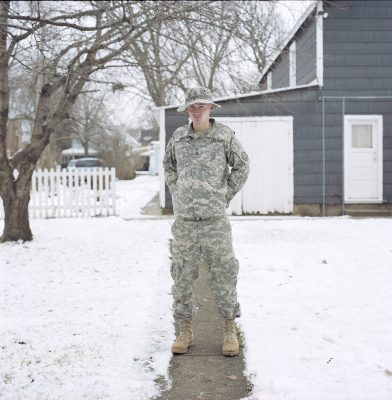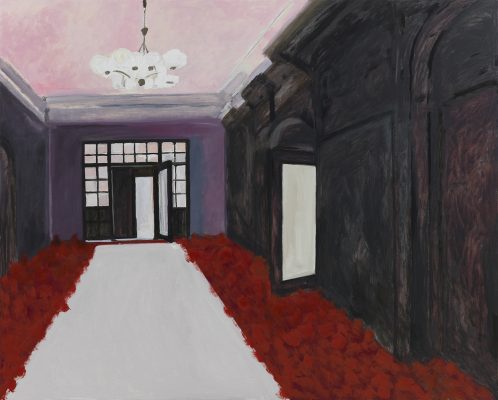Two hundred names are inscribed in a totemic list that opens Alice Oswald’s Memorial. The deaths of the Greek heroes, recounted over 400 pages in the Iliad, are stunningly compressed across four double pages. Their deaths are a foregone conclusion; but their capitalised names, framed by the blankness of the page, carry the hefty weight of each man’s life. The second part of the poem, which recounts the heroes’ often unheroic traits, lays bare the insanity of war; the blind momentum that turns a man into ‘a terrible numbness / Turned inside-out and taking over everything.’ In the Homeric myth, war is second nature, a duty assumed by the warrior, undeterred by the destruction reaped. Soldiers ‘hurried to darkness’, race into the arms of death, the noble seal of defending one’s country. For Simone Weil, writing on the eve of the Second World War, there was no terrible beauty to be born of combat. War, that supposed leveller of class and race, is seen as a systematic machine that levels interiority and petrifies everyone in its midst. In Oswald’s poem each forsaken soldier is given their due, which is to say, their doomed leave-taking. In the Greek myths death is the unflinching end, the future for the soldier born under its sign. The Greeks conducted wars, Weil writes, as ‘geometricians of virtue. We are only geometricians of matter,’ or as Marco Roth writes in a recent essay, ‘drone philosophers’.
In modern times, peace is seen as the ultimate, if unrealistic, goal; warfare is, if inescapable, an aberration. Just as the notion of heroism died a collective death in the wake of that grand misnomer, the Great War, the horror of combat has become such a worn truism that it seems to carry little more traction that the jarring jingoism of Glory, Sacrifice and Patriotism excoriated by the First World War poets who saw that the unknown soldier would reap ‘no dividends from time’s tomorrow’. There had been military catastrophes in the past – the Charge of the Light Brigade – but these were seen as indictments of military strategy, rather than a condemnation of the larger cause of which they were part. The Great War was the first conflict for which the myth of the hero became bitterly ironicised by the serving poet. As Adam Hochschild writes in To End All Wars, tens of thousands of men of military age, who recognised the war for the sheer destruction that it was, spoke out against conscription. In the years following the armistice, the anti-war spirit solidified in a protest movement so vociferous, as Orwell noted, that ‘even the men who had been slaughtered were held in some way to blame.’ In the US, that war was Vietnam. It was the first war to be broadcast on national television and to spark an organised anti-war movement.
One of war’s most irresistible techniques is its capacity to create the illusion of consensus. Not only of its supporters, but particularly of its practitioners, whose careers depend upon them toeing the party line. The suppression of military dissent abets disastrous, often illegitimate, wars. The Iraq War is a case in point, conceived in deceit and enacted behind a screen of official secrets, lies and distortions. Where there is fighting, there is no room for thought, so runs conventional wisdom. Shoot first, ask questions later. But as Owen Sheers writes of three ordinary British lads who find themselves in the midst of carnage in Afghanistan, ‘fighting’s ninety per cent waiting, / and when you’ve got that much time, you think.’ The armed forces demand absolute, unquestionable loyalty to ‘we’ the army, a ‘we’ that does not always correspond with a soldier’s notions of rightness or wrongness, or indeed that of ‘we’ the nation. Foreign policy and information wars seem increasingly to occupy the same terrain, and they are responded to in the same way: by criminalising dissent. Beyond the heroism of the whistleblower’s public display of dissent, there lurks a quieter voice – the soldier who has no ostensible anti-authoritarian agenda, but who finds him or herself in a predicament which he or she cannot morally condone. Having signed up in good faith the soldier feels betrayed by a system that runs contrary to his or her notions of justifiable violence. Conscientious objectors do not pose the same threat as the hacker – their action is constituted by a negative choice, not a threat; but they still wield a powerful tool in an institution that depends upon conformity for its power.
*
A red velvet cinema chair stands in the centre of the auditorium of the Lebanese Pavilion at this year’s Venice Biennale. In front is a looping 16mm film that shows the bombing of the hillside of the southern Lebanese town of Saïdain 1982. Projected onto the back wall is a 45-minute film that non-sequentially recounts the story of an Israeli air force pilot assigned to bomb the city, shortly after the Israeli invasion. The pilot, who recognised that his assigned target was a school, veered off course, dropping his bombs into the Mediterranean Sea instead. The school was bombed several hours later by another pilot, but the anecdote exerted a particular foothold on the local imagination. The rumour that circulated in Saïda was that the pilot, whose family had been from the town’s old Jewish community, felt too attached to the area to harm its inhabitants. Among those captivated by the story was the artist Akram Zaatari, whose father founded the secondary school, which he ran for two decades. For years Zaatari had heard differing versions of the story, but like all myths he was unsure as to its origins. In 2010, while in conversation with the Israeli filmmaker Avi Mograbi, he learnt that the story was not only accurate, but that the pilot was still alive and living in Haifa. He arranged to meet the man, Hagai Tamir, in Rome. Now in his sixties, Tamir told Zaatari that he was not in fact from the Jewish community; that he had joined the army out of his love, harboured since a child, of flying. Tamir had never been interested in planes as war machines; but in a militarised society the only way to realise his aerial goal was by signing up. Tamir left the army in the early 70s to study architecture. It was only when he was called up to serve in 1982 that he realised that, after eight years of civilian life, indiscriminate destruction seemed untenable.
‘Letter to a Refusing Pilot’, Zaatari’s three-part installation, stages an enigmatic story that explores gaps in official histories. The interconnected elements pose questions about how we conceive the enemy and whether we have the right to refuse an order that we are contractually obliged to carry out in the interests of the state. The exhibition brochure notes that the title is a reference to Albert Camus’s Letter to a German Friend, published during the occupation, in which he writes, to an unknown interlocutor, ‘I should love my country and still love justice.’ For Zaatari, the invasion of Iraq and the technical shift in warfare has prompted renewed discussion about the relationship between individual conscience and the circumstances of war. ‘I don’t see soldiers that simply obey orders as innocent,’ Zaatari says. ‘I think there’s a certain level of responsibility vis-à-vis humanity that one has to assume. An individual cannot stop the military machine but it is important that he continues to try according to a set of personal and ethical codes. Tamir’s action is important because it sets a precedent. It doesn’t change the course of history; it doesn’t change anything on the ground; but it says a lot about the individual and the military institution. When you’re facing the dark side of war, like the current situation in the Middle East, your only hope is that someone from the invasion says no.’ Zaatari’s film about the refusal to act is a dramatisation of that ‘no’ that reconsiders dissent as a generative act. The spotlighted chair which stands like an empty throne evokes the officer’s physical presence in the connection between the 1982 footage and the contemporary film. It’s a seat on which visitors are invited to sit.
Zaatari, who was 16 at the time of the invasion, has worked on the project for more than ten years, burrowing into the archives of people of a similar age to see how they experienced the same moment in history. The longer film opens with a pair of gloved hands leafing through an old copy of Antoine Saint-Exupéry’s The Little Prince, the 1943 story of juvenile existentialism. Saint-Exupéry, who was himself a wartime aviator who went missing during his last mission over the Mediterranean, writes about the strangeness of the adult world from a 6-year-old’s perspective. Zaatari, who is drawn to the multilayered opacity of things, stops on one particular page of the book where the child is asked by a prince to draw a sheep. He is not pleased with the result and instead, draws a box in which you can imagine whatever exists inside it. The same hands leaf through sepia photos of Zaatari’s family; the camera skips to a shot of those hands painstakingly sketching an outline of a schoolhouse and a paper airplane.
Acutely aware of the associativeness of memory, its lapses and distortions, Zaatari opts for a filmic narrative that owes something to collage, incorporating images and sounds so that Françoise Hardy’s Comment Te Dire Adieu plays resonantly alongside explosions, and journal entries recount the latest American blockbuster alongside the worst days of fighting. It’s a starkly different portrayal of war, eliding both official history and autobiography to favour a more provisional understanding of history in which personal anecdotes and references to momentous events nestle side by side, as a teenager’s exploratory urges meet the conditions of wartime. The camera then shifts to a sequence of meditative shots of children moving through the hallways of the school today. It lingers on a fuchsia rose, with a gardener pruning away in the background, and fixates on a sculpture that at first glance looks like two men wrestling, but then seems to show a lover’s embrace. Intermittently the ominous sound of planes flying overhead is heard. Two schoolboys are shown climbing onto the roof of the school, where they fold their schoolwork into paper airplanes and throw them in the direction of the sea. It’s a powerful image in which Tamir’s ambitions and the Little Prince’s imaginative flights meet, a receding point in which the love of flying becomes the violence of flying. Today Tamir flies kites.
*
In his 1968 essay ‘On Not Prosecuting Civil Disobedience’, Richard Dworkin establishes a set of principles that distinguishes conscientious disobedience from lawlessness. ‘The law that makes it a crime to counsel draft resistance,’ he writes, ‘stifles those who oppose the war, because it is morally impossible to argue that the war is profoundly immoral, without encouraging and assisting those who refuse to fight it.’ Last year, almost fifty American military veterans tossed their medals at a Nato summit held in Chicago with the qualification: ‘I want to live by my conscience, rather than be a prisoner of it.’ Underneath their military camouflage, white letters peered out of black t-shirts that read, ‘Veterans against the Iraq War’. Peace signs were thrust to the heavens. Hart Viges joined the US Army as a direct response to the 9/11 attacks. He saw it as his duty to ‘liberate the Iraqi people and clean up what the US had not finished off in the first Gulf War’. Viges was deployed to Iraq as an infantry paratrooper on the front line in 2003 and recounts his easy acceptance of the circumstances of war: ‘All through Al Samawah, parts of Fallujah, and when we got to Baghdad, people were cheering saying, “Yes Bush! No Saddam!” It felt good. We were there to take care of a bad guy and give the country back to the people. But we stayed.’ After the initial fervour of combat, Vigis began to sense that the invasion was ‘like a dream that we were trying to convince ourselves was real.’ ‘Violence can be justifiable,’ Arendt writes, ‘but it never will be legitimate. Its justification loses in plausibility the further its intended end recedes into the future.’ Outspoken British veteran Joe Glenton speaks of a similar discordance between ‘out there’ and back home; the disjunction between the video game hyper-reality of combat and the realism of civilian life. Shortly after returning from Iraq on leave, Vigis, who was suffering from undiagnosed PTSD, applied for conscientious objector status. His application was accepted nine months later and he was honourably discharged.
Vigis is one of fifty dissenting soldiers that photojournalist Jo Metson Scott has profiled for her book The Grey Line. Over a five-year period she travelled across theUS, listening to stories from soldiers who have experienced the reality of war in a way that no journalist can ever convey. The book reads like a beautifully produced, provocative scrapbook, with colour portraits of the veterans alongside their testimonies, which take the form of journal entries, emails, trophy snaps and letters home. Their motives for laying down their weapons are as various as their positions and experiences. Most recount an epiphanic moment when the horror of war suddenly dawned upon them and the bellicose camaraderie seemed no longer tenable. ‘The idea [of military training] is to get you to think less and less of the other as being human,’ says Josh Steiber, who joined the army as an infantryman aged 18 and was deployed to Iraq for 14 months. ‘For example, the drill sergeant would lead you in songs. One of them went:
I went down to the market where all the women shop,
I pulled out my machete and I began to chop,~
I went down to the park where all the children play
I pulled out my machine gun and I began to spray.
These are men, some of whom had first hand exposure to the Abu Ghraib images that shocked the nation(s) and for whom the stories of corpse mutilation and civilian mistreatment were routine. Despite the atrocities they witnessed, opting out was never the easy option. ‘It wasn’t until at least four or five months in,’ says Aidan Delgado, who spent six months in Abu Ghraib, ‘that I began to realise that it wasn’t that I was a bad person, but that I was participating in something that was wrong.’ In one of Aidan’s photographs, a member of his unit is seen scooping out a prisoner’s brains with a plastic spoon. Soldiers are not trained to admit defeat; their decision materialises from sleepless nights, spent wrestling with their conscience, trying to discern whether the qualifying moral factor of their actions is the sincerity of belief or the objective justness of a cause, negotiating that fine line between compliance and consent. The soldiers’ decisions showed considerable courage at a time when any action that was deemed unpatriotic was met with moral outrage. Many lost everything – their jobs and families – and gained a prison sentence.
‘I wanted to fight for justice and equality and freedom,’ writes Mike Prysner, a veteran and co-founder of the organisation March-Forward!, but ‘I realised that fighting those things wasn’t fighting the wars that I was ordered to by the US government; it was fighting against the US government. So I still feel that what I’m doing now, I’m doing for the same basic reasons that drove me to join the military… It just ended up being the opposite of what I thought I needed to do.’
Like Zaatari, Metson Scott refrains from offering any hard-and-fast (anti-)narratives of war; choosing instead to focus on the individual, whose stories serve as their own political shrapnel. The book also reflects on the fallout of speaking out – from soldiers who have been honourably discharged and lauded to those who have been outcast and imprisoned. What emerges from many of the stories is an image of war as labour by other means. If the First World War was a vast factory where safety standards were systematically flouted, combining the worst aspects of field labour with industrial shift-work, the armed forces today operate like a cheap insurance company (‘We were at McWar,’ as Glenton puts it), outsourcing jobs and privatising risk. ‘We were both there in our own way for money, me, the Indians [who earn less than $5 a day and drive without armour or weapons] and the American companies,’ says Malachi Muncey, who enlisted in the US National Guard aged 17. It’s about kids just out of college with no means to pay for their education. Recruiting campaigns offer promises of employment skills and tuition benefits, while eliding discussion of the realities of combat. But war does nothing to increase the prospects of the young. In the USA military veteran takes their own life almost every hour; unemployment is high and PTSD is rife.
The Grey Line opens with a shot of Robert, the first soldier that Metson Scott met in small town Indiana in 2007. The whitewashed landscape is as far as can be imagined from the arid rubble of the Iraqi plains. The town seems deserted, and in the midst of the falling snow is clean-shaven Robert with his candid boyishness (he was still a teenager at the time), underdressed in his military attire (it’s minus ten degrees outside). The uniform does its duty even in a Midwestern winter (the military doesn’t adapt to the changing seasons; it bears them out), its teal and eggshell patchwork merging into the frosty background. There’s a transcendentalist glimmer to the shot, as if Robert were a beacon of Emersonian self-reliance, rather than a coward in the public eye. On the opposite page, barely legible beneath the gathered snow, a placard reads: ‘Your Savior Has Come’. Robert, who had served as a radio commander in the US Army, had never been in direct combat. But over time, he became increasingly troubled that his position helped facilitate death. He had applied for, and was denied, conscientious objector status. On his last period of leave from Iraq, he went AWOL. His plan had been to lie low for thirty days before turning himself in, at which point he would have been classed as a deserter, and risk a prison sentence of up to five years. But when Robert’s sister found out, she reported him to the police. When his picture was taken, he was sheltering in the basement of an elderly pacifist couple who had taken him in. Ryan Endicott, who joined the Corps infantry in 2004, aged 20, and served in Iraq for seven months, received little more support from his family. ‘My brother publicly disowned me on Facebook for everyone to see. He left comments about how I was a puppet, and being used… He said I wasn’t his brother anymore, than I wasn’t even a man.’
In the First World War around 16,000 British men were recorded as applying for conscientious objector status after conscription started in 1916; in the Second World War, that number rose to 61,000, with a comparable mobilised force of around 5 million. COs were denounced for being either cowardly or dangerous (or both). Orwell spent much of WWII churning out political propaganda in which he rhymed pacifist with ‘fascist’ and condemned COs as ‘pro-Nazi’. ‘War will exist,’ wrote John F. Kennedy in 1965, ‘until that distant day when the conscientious objector enjoys the same reputation and prestige that the warrior does today.’ Of the 2.7 million service men and women in active or reserved forces in the US in 2002, 29 were discharged as COs. The US Department of Defense defines conscientious objection as a ‘firm, fixed and sincere objection to participation in war in any form or the bearing of arms, by reason of religious training and belief,’ for discharge or non-combat service. A serviceman must also object to war under all circumstances rather than, say, express a particular moral objection to (the illegality of) the Iraq War. Applying for CO status is a convoluted procedure that involves interviews, essays and letters from character witnesses. Discharges range from the administrative ‘Honourable’ which entitles servicemen to receive the complete benefits of a veteran to the punitive ‘Dishonourable’, which divests an officer of any service benefits and is usually conferred by court martial as part of a sentence. As Pablo Paredes, a former weapons control technician, argues, ‘If it’s a principled reason then there should be a principled process.’
Collectively the Iraq and Afghanistan wars will be the most costly in US history, amounting to between $4 and $6 trillion, and there is no ‘peace dividend’ is in sight. The conflicts have exerted little pressure in recent elections, suggesting that war is increasingly conceived less as an aberration than a condition to be endured. The lesser-told, personal cost of war will leave an equally lasting legacy. ‘In general,’ Arendt writes, ‘the degree of responsibility increases as we draw further away from the man who uses the fatal instrument with his own hands.’ Discussion today is less about deliberating pilots than a pilotless campaign of controlled killing without borders, bringing the virtual reality of simulated games one step closer. Removed from the immediacy of combat, the drone pilot is forced to conduct warfare within a markedly different set of temporal and environmental constraints. The battleground becomes less a zone of immediate threats and knee-jerk responses than a months-long surveillance programme, trailing a subject, weighing up the ‘propriety’ of death. Writing in the New York Times, philosopher John Kaag assesses the ethical implications of ‘this new breed of remote control soldier’. He cites a 2011 Pentagon study that reveals that nearly 30 per cent of drone pilots experience what the military refers to as ‘an existential crisis’, a burden, he points out, that was formerly borne by leaders and military strategists. In the Iliad war is seen as something visceral and ultimate, an activity that the warrior participates in inveterately, and whose legitimacy is derived in past actions. Forced to switch back and forth between alternate realities, with a justification that resides in an ever receding future, the philosophy of means and the safety of bases don’t look any more cosy for Kaag’s ‘armchair soldier’.
– The final paragraph of this article was amended on Tuesday 15 October to correctly attribute the philosopher John Kaag.






